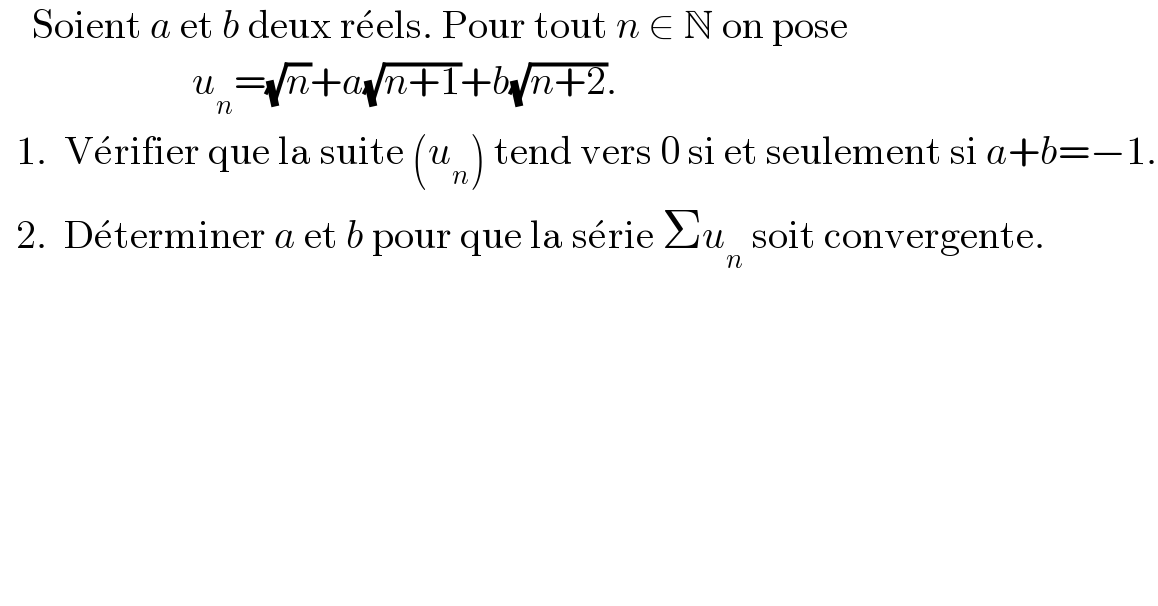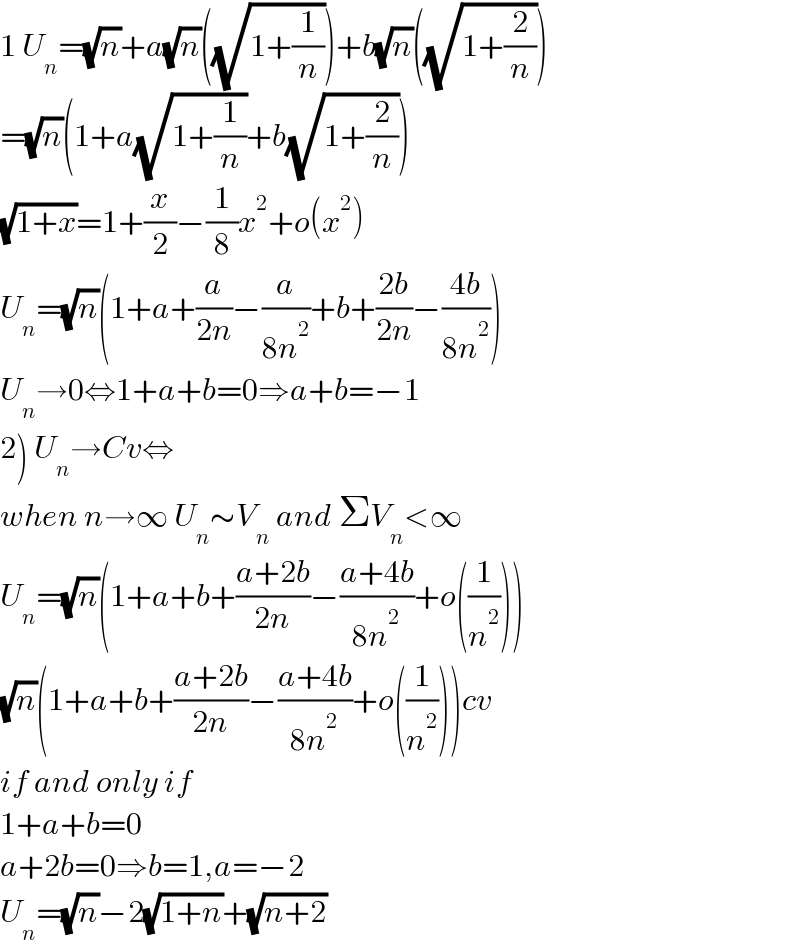Question Number 173795 by Ar Brandon last updated on 18/Jul/22

$$\:\:\:\:\mathrm{Soient}\:{a}\:\mathrm{et}\:{b}\:\mathrm{deux}\:\mathrm{r}\acute {\mathrm{e}els}.\:\mathrm{Pour}\:\mathrm{tout}\:{n}\:\in\:\mathbb{N}\:\mathrm{on}\:\mathrm{pose} \\ $$$$\:\:\:\:\:\:\:\:\:\:\:\:\:\:\:\:\:\:\:\:\:\:\:\:{u}_{{n}} =\sqrt{{n}}+{a}\sqrt{{n}+\mathrm{1}}+{b}\sqrt{{n}+\mathrm{2}}. \\ $$$$\:\:\mathrm{1}.\:\:\mathrm{V}\acute {\mathrm{e}rifier}\:\mathrm{que}\:\mathrm{la}\:\mathrm{suite}\:\left({u}_{{n}} \right)\:\mathrm{tend}\:\mathrm{vers}\:\mathrm{0}\:\mathrm{si}\:\mathrm{et}\:\mathrm{seulement}\:\mathrm{si}\:{a}+{b}=−\mathrm{1}. \\ $$$$\:\:\mathrm{2}.\:\:\mathrm{D}\acute {\mathrm{e}terminer}\:{a}\:\mathrm{et}\:{b}\:\mathrm{pour}\:\mathrm{que}\:\mathrm{la}\:\mathrm{s}\acute {\mathrm{e}rie}\:\Sigma{u}_{{n}} \:\mathrm{soit}\:\mathrm{convergente}.\:\: \\ $$
Commented by Ar Brandon last updated on 18/Jul/22

$$\mathrm{Q2}. \\ $$
Answered by mindispower last updated on 18/Jul/22

$$\mathrm{1}\:{U}_{{n}} =\sqrt{{n}}+{a}\sqrt{{n}}\left(\sqrt{\mathrm{1}+\frac{\mathrm{1}}{{n}}}\right)+{b}\sqrt{{n}}\left(\sqrt{\mathrm{1}+\frac{\mathrm{2}}{{n}}}\right) \\ $$$$=\sqrt{{n}}\left(\mathrm{1}+{a}\sqrt{\mathrm{1}+\frac{\mathrm{1}}{{n}}}+{b}\sqrt{\mathrm{1}+\frac{\mathrm{2}}{{n}}}\right) \\ $$$$\sqrt{\mathrm{1}+{x}}=\mathrm{1}+\frac{{x}}{\mathrm{2}}−\frac{\mathrm{1}}{\mathrm{8}}{x}^{\mathrm{2}} +{o}\left({x}^{\mathrm{2}} \right) \\ $$$${U}_{{n}} =\sqrt{{n}}\left(\mathrm{1}+{a}+\frac{{a}}{\mathrm{2}{n}}−\frac{{a}}{\mathrm{8}{n}^{\mathrm{2}} }+{b}+\frac{\mathrm{2}{b}}{\mathrm{2}{n}}−\frac{\mathrm{4}{b}}{\mathrm{8}{n}^{\mathrm{2}} }\right) \\ $$$${U}_{{n}} \rightarrow\mathrm{0}\Leftrightarrow\mathrm{1}+{a}+{b}=\mathrm{0}\Rightarrow{a}+{b}=−\mathrm{1} \\ $$$$\left.\mathrm{2}\right)\:{U}_{{n}} \rightarrow{Cv}\Leftrightarrow \\ $$$${when}\:{n}\rightarrow\infty\:{U}_{{n}} \sim{V}_{{n}} \:{and}\:\Sigma{V}_{{n}} <\infty \\ $$$${U}_{{n}} =\sqrt{{n}}\left(\mathrm{1}+{a}+{b}+\frac{{a}+\mathrm{2}{b}}{\mathrm{2}{n}}−\frac{{a}+\mathrm{4}{b}}{\mathrm{8}{n}^{\mathrm{2}} }+{o}\left(\frac{\mathrm{1}}{{n}^{\mathrm{2}} }\right)\right) \\ $$$$\sqrt{{n}}\left(\mathrm{1}+{a}+{b}+\frac{{a}+\mathrm{2}{b}}{\mathrm{2}{n}}−\frac{{a}+\mathrm{4}{b}}{\mathrm{8}{n}^{\mathrm{2}} }+{o}\left(\frac{\mathrm{1}}{{n}^{\mathrm{2}} }\right)\right){cv} \\ $$$${if}\:{and}\:{only}\:{if} \\ $$$$\mathrm{1}+{a}+{b}=\mathrm{0} \\ $$$${a}+\mathrm{2}{b}=\mathrm{0}\Rightarrow{b}=\mathrm{1},{a}=−\mathrm{2} \\ $$$${U}_{{n}} =\sqrt{{n}}−\mathrm{2}\sqrt{\mathrm{1}+{n}}+\sqrt{{n}+\mathrm{2}} \\ $$
Commented by Ar Brandon last updated on 18/Jul/22
Merci
Commented by Tawa11 last updated on 19/Jul/22

$$\mathrm{Great}\:\mathrm{sir} \\ $$
